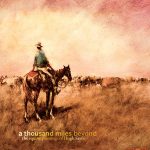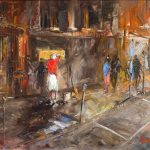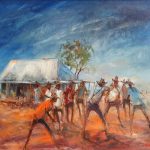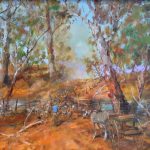The Rabbiter and his Daughter (Yelarbon, SW Qld) – SOLD
Detail photos for this Artwork
This oil painting by Hugh Sawrey, like many of his wonderful pieces, tells and preserves a story about rural Australia, recalled from his personal experiences of having lived in and travelled through many of these areas as a stockman.
One of the distinguishing features of Sawrey’s works is that he often includes as part of his painting titles the location of his scenes. In the case of this painting, it is Yelarbon in South West Queensland, a tiny town near the New South Wales border, midway between Goondiwindi and Inglewood on the Dumaresq River.
Surrounded by desert spinifex country, Yelarbon takes its name from the lagoon on the edge of town, derived from the Aboriginal word for water lily or lagoon. The Yelarbon Lagoon is a permanent water source that led to the town developing in such a remote location.
“The Rabbiter and his Daughter” depicts the scene of a rabbit trapper and his daughter travelling with their dutiful old grey horse and cart through the sparse desert country near Yelarbon. Rabbit carcasses dangle from the rear of their cart. Dust trails from the cart as the horse plods onward under a blue outback sky.
In this painting Sawrey records a chapter in Australia’s rural history, and by doing so pays homage to the resilience and industriousness of men who worked hard to survive and provide for their families by supplementing their income with trapping and selling rabbits.
Rabbits became an important industry in Australia from the late 1880’ and into the mid 1950’s, providing employment for many families and bringing income and advances in industrialization.
Historically, the Yelarbon district was used for general grazing. After the railway line was extended to nearby Goondiwindi in 1908, wheat and cotton growing were established, and then with advances in refrigeration in the 1800’s, the way was paved for another major industry to develop in Yelarbon – the trapping and freezing of rabbits!
The first rabbits in Australia arrived with the First Fleet from Britain in 1788. By the 1870’s, feral rabbits, previously introduced for hunting, had exploded into plague proportions in rural areas and became a serious problem.
However rabbits did create a thriving industry in Australia for meat and pelts and following in the footsteps of other factories in southern states, in 1916 Yelarbon became the first town in Queensland to open a rabbit freezing works.
Trappers travelled from far and wide to consign carcasses to Yelarbon, and it eventually became known as “rabbit town”. Sawrey’s painting chronicles this part of Yelarbon’s history depicting the trapper and his daughter, bound most probably for the freezing works.
Within a year of opening, the Yelarbon freezing works had processed over 110,000 rabbits and was supplying meat to markets around southern Queensland, plus pelts and furs to factories and hat makers in Sydney and Melbourne.
By 1929 the rabbit industry was the largest employer of labour in Australia. Refrigerated meat was being exported by ship to Britain, North America, and Asia, as also provided affordable meat to the domestic market.
Rabbit meat sustained many families, particularly during the Depression years of the 1930’s. The lower price of rabbit, compared to other meats meant it came to be known as “underground mutton” and “poor man’s chicken” but it kept many people from going hungry and despite low prices, trappers were still able to make enough for their families during difficult times.
Rabbit numbers increased during the Second World War in 1939, when most of the young trappers left to enlist in the Army, but trapping resumed after the war and some companies grew very rich.
However, from the 1950s the industry faced major challenges. The introduction of battery chicken farming that provided very cheap chicken meat and the devastating effects of the myxomatosis disease on wild rabbit populations, meant that the rabbit industry died out.
In 1955 the Yelarbon rabbit works closed its doors.
The district now focuses on grain and cotton as well as tobacco, and new industries such as olive and pecan growing have developed.
These days Yelarbon is a tiny town populated by only a few hundred people and has struggled through years of drought.
However, very recently in July 2019, Yelarbon celebrated the completion of the painting of a large mural on four of its eight large grain silos, with an artwork entitled “When the Rain Comes”.
Painted by the artists Jordan Bruce, Jordache Castillejas and Steve Falco, who form the Brisbane based artist’s collective called the “Brightsiders Group”, the 24 metre high silos owned by GrainCorp, now feature a scene of a little boy launching a paper sail boat onto the Yelarbon Lagoon.
The project was funded by a grant from the federal government’s Drought Communities Programme Extension which aims to revitalise small rural, drought stricken communities across Australia.
The Yelarbon silos are intended to be part of the National silo art trail, with hopes that tourism and increased visitation to Yelarbon will contribute to a revitalisation of business in the town.
























































































